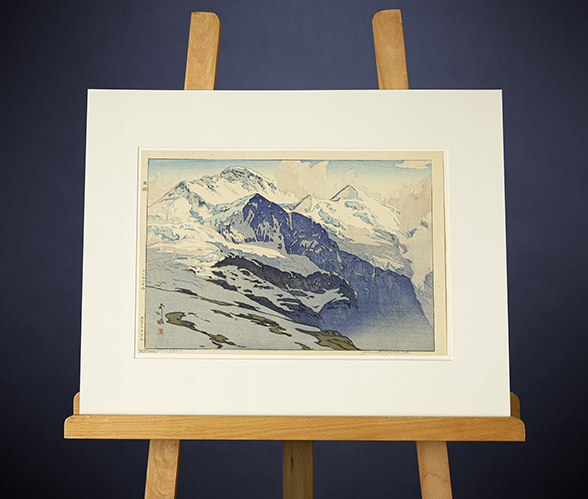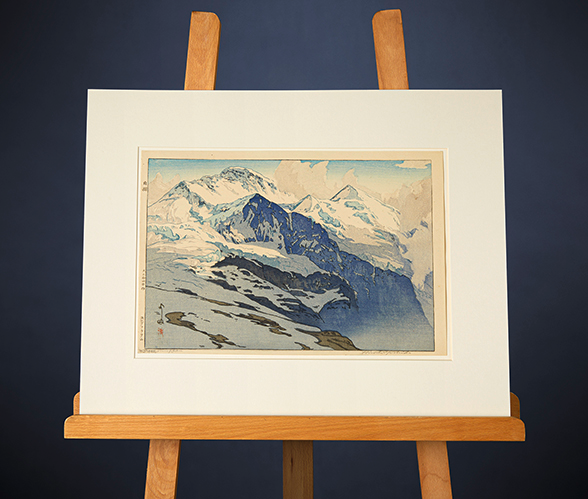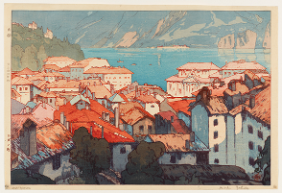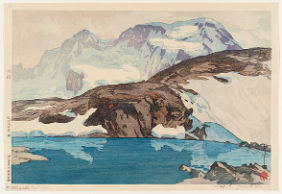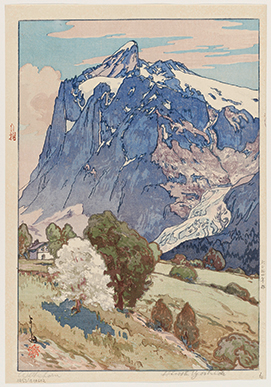After a trip to Europe, the Japanese painter and master of the colour woodblock print, Hiroshi Yoshida (1876–1950), depicted the Jungfrau and fused European and Japanese traditions of landscape depiction. What made him choose the Jungfrau?
By Lisa Oberli
In 1925, Hiroshi Yoshida, then 49, published a colour woodblock print featuring a view of the Jungfrau. His depiction of the world-famous titan of the Bernese Oberland from relatively close up – probably from the Wengernalp – is in some ways like a portrait of the mountain. The snow-capped peaks are rendered in light blue, grey and white tones, while the contours of the distinctive mountain range are clearly defined with sharp lines. The rock formations that fall away into the shady Lauterbrunnen Valley are captured in dark blue tones, while mist is rising from the valley floor. The cool colour palette points to the bitter cold of a winter day in the high mountains and positions the sublime mountain range close to the heavens.
Swiss motif – Japanese colour woodblock print
By choosing his motif, Hiroshi Yoshida joined the ranks of centuries-old Swiss iconography. In the early 18th century, as the Alps were being discovered by philosophers, writers, scientists and mountaineers, artists also wanted to capture Switzerland's famous mountain range with its snowy peaks. Over time, the intimidating glaciers, sheets of ice and masses of rock lost some of their menace and instead became 'picturesque amusement' that found its way into living rooms and studies in the form of text and pictures. From the 19th century, the traditional 'Oberland Tour' took travellers from all over the world from Interlaken to the Lauterbrunnen Valley, and from there by foot, on horseback and later by train on to Wengernalp and Kleine Scheidegg, and on the other side back down to Grindelwald. The highlight of the trip was usually the Jungfrau which could be seen from as far away as Bern, and became a source of fascination more than any other mountain.
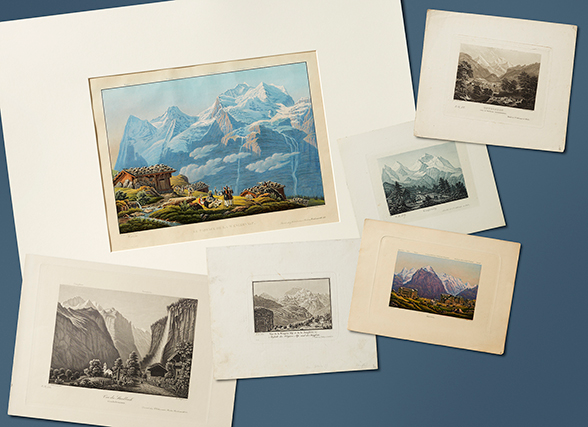
Yoshida's view of the Jungfrau differs in many respects from the landscapes that were popular during Switzerland's development as a tourist destination in the 18th and 19th centuries. It does not feature lush mountain meadows or authentic Alpine huts, and there are no carefully placed figures or romanticised pastoral scenes to be seen. What is special about Yoshida's view is instead that it fuses a Swiss visual motif with the techniques and traditions of Japanese woodblock printing. And yet there is a thematic parallel: in Japanese woodblock printing, too, a form of landscape depiction developed in the 19th century, which focused on famous regions ('meisho') and landscapes ('fūkei-ga') along tourist routes and – similar to what was happening at that time in the West – romanticised the grandeur and beauty of nature.
Yungufurau Yama
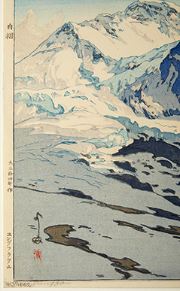
In this picture, the mountain is pretty much all we can see, but in differentiated shades of colour. The image, which is produced using a complex multi-plate relief printing process, is composed of a large number of colours, each of which requires a separate printing block. Hiroshi Yoshida worked with up to forty such blocks in his woodblock prints. The overlapping and at the same time merging layers of the image take inspiration from watercolours.
As the piece was aimed at an international audience, it is labelled in both Japanese and Latin script. The Japanese signature in the bottom left-hand corner of the image is decrypted on the lower right-hand edge, where we see “HiroshiYoshida” written in Latin script. The same goes for the title: on the left-hand edge it is written in Japanese script (“Katakana”) and says “Yungufurau Yama” and in Latin script in the bottom left it says “Jungfrau”.
The Europe series
What brought Hiroshi Yoshida to the Jungfrau? Yoshida was well travelled and worldly and was aware of the West's enduring enthusiasm for Japanese art. After the forced opening of Japan in 1854, Japanese woodblock prints were exported en masse to Europe and the United States and became sought-after collectors' pieces. From his studies and stays abroad in the US and in Europe (1899 and 1903–06), Yoshida was not only familiar with Western painting and its use of perspective and shadow, but also Western tourist attractions. Following the Great Kantō earthquake in September 1923, which devastated Tokyo and robbed many Japanese artists of their livelihoods, he set off again with his wife on a trip through the US and Europe. When he returned in August 1925, he set up his own workshop and published a series of colour woodblock prints depicting sites in Switzerland, Italy, Greece and Egypt. His Jungfrau works were part of a series alongside views of the Wetterhorn, Breithorn, Matterhorn, the city of Lugano, a canal in Venice, the ruins of the Acropolis and the Sphinx, all of which he probably added to his visual repertoire on his return to Japan.
Four of the in total six views of Switzerland by Hiroshi Yoshida ended up in the Swiss National Library in 1953, where they complement the prints collection of views of places and landscapes in Switzerland.
Hiroshi Yoshida (1876–1950), was a Japanese graphic artist, painter and illustrator. He studied Western-style painting in Kyoto and Tokyo from 1893. From 1899 he undertook various trips to the United States and a number of European countries. He moved into woodblock printing in 1920. Until 1923 he worked with the publisher Watanabe Shōzaburō, who modernised the traditional Ukiyo-e-woodblock printing to make Shin-hanga, the “new woodcut”. In 1925, he set up his own workshop and published various prints featuring Western landscapes.
Bibliography and sources
- Matthias Oberli: Von «Wunder-Bergen» und «Colossalischen Schreckenssäulen». Die Entdeckung der Gletscher in der Schweizer Kunst des 17. und 18. Jahrhunderts, in: Roger Fayet, Regula Krähenbühl, Bernhard von Waldkirch (Ed.), Wissenschaft, Sentiment und Geschäftssinn, Zurich: Scheidegger & Spiess, 2017, p. 32–54.
- Heinz J. Zumbühl, Samuel U. Nussbaumer, Hanspeter Holzhauser, Richard Wolf (Ed.): Die Grindelwaldgletscher: Kunst und Wissenschaft, Bern: Haupt, 2016.
- Katharina Balmer: Als Gletscher noch aus Eis waren. Jungfrauregion einst und jetzt, Bern: Ott, 2015.
- Daniel Anker: Jungfrau, in: Historical Dictionary of Switzerland (HLS), version dated 11.02.2008.
- Tadao Ogura, Yoshida Hiroshi zen mokuhangashū = The complete woodblock prints of Yoshida Hiroshi, Tokyo: Abe Shuppan, 1987.
- Friedrich B. Schwan, Handbuch japanischer Holzschnitt: Hintergründe, Techniken, Themen und Motive, Munich: Iudicium, 2003.
Last modification 01.05.2023
Contact
Swiss National Library
Prints and Drawings Department
Hallwylstrasse 15
3003
Bern
Switzerland
Phone
+41 58 462 89 71


